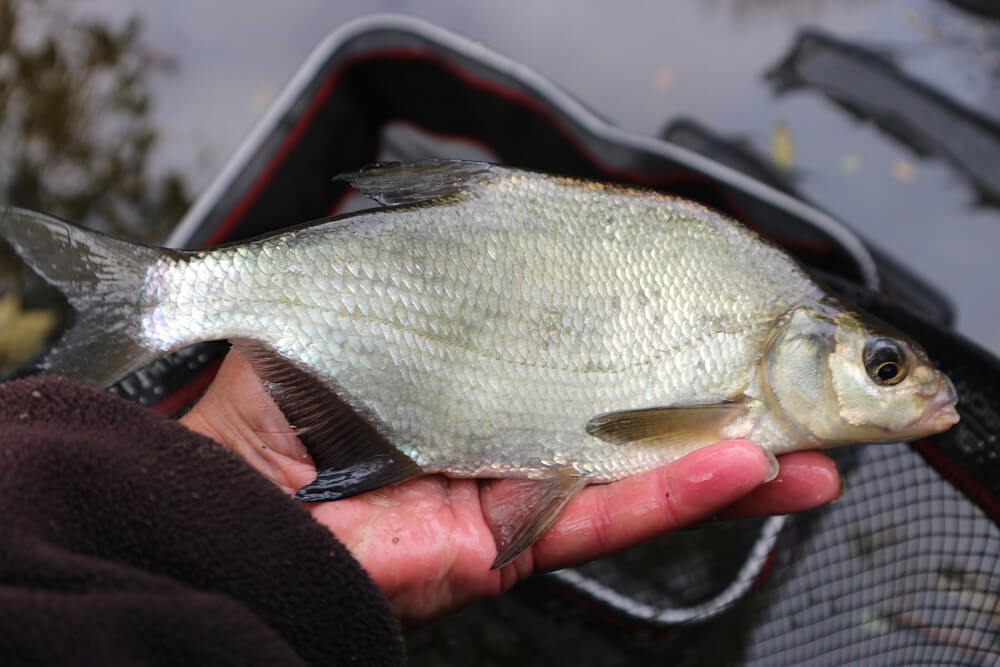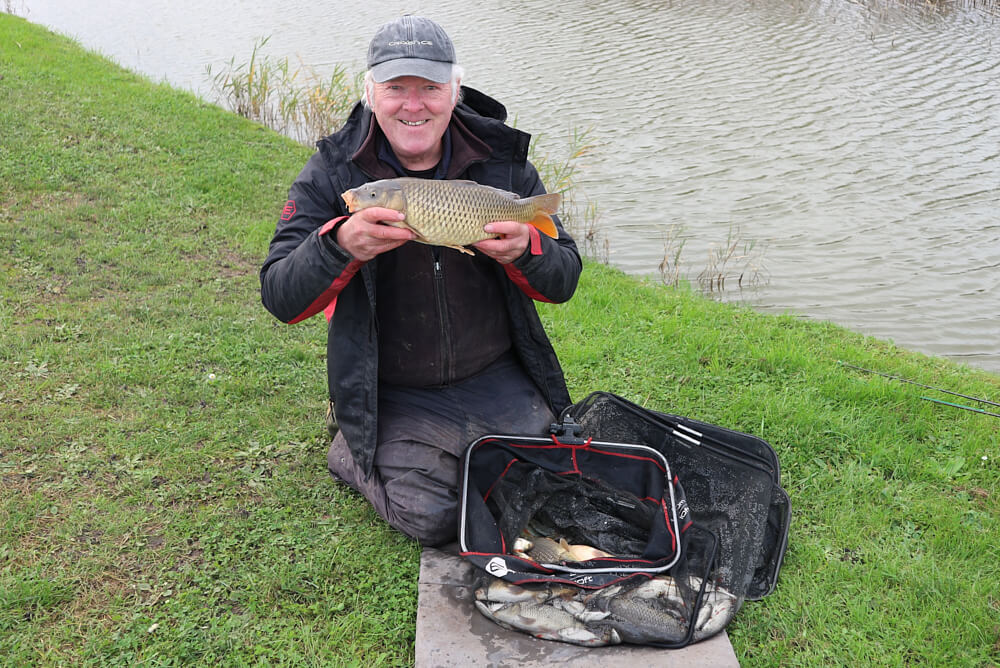Busy River
I made a return visit to the Briggate River, a flowing stretch of the Middle Level system south of Whittlesey. The upstream end is a long hike, but it’s heavily overgrown on the far bank, eliminating any disturbances from the park opposite. However, the towpath behind was hectic at times, with bikers, joggers, and dog walkers. I decided it was too dangerous to attempt unshipping a long pole. Instead, I tackled up a light waggler rig on my Cadence CR10 11ft Match 2# Match Rod. A local stopped by for a chat and informed me some big chub and perch inhabit this area. The far bank certainly looked the part. I tried casters over there, but it was full of sunken leaves and branches. With the main flow down the middle, the presentation wasn’t that great, either. A change of tactics was needed, but overhead trees limited my options.

Special Float
Rummaging about in my seat box, I found this ancient mini stick float. It doesn’t take much shot, but its heavy cane stem ensures it casts nicely. I set it up to run down the deeper boat channel, starting off with spread number 6s. Occasional rafts of floating leaves made the strung format tricky, so I bulked the main shot together, just above a 12-inch hook length. The latter had two evenly spaced number 10 micros on it and a size 18 medium wire hook. I’ve used this set-up a lot on small rivers, mainly for chub. The float has a modified hollow plastic tip, which is translucent, so it shows up better when trotting at distance. Loose feeding casters, with a single red maggot on the hook, produced plenty of bites straight away. Lots of small perch were buzzing about, and trotting through at the speed of the current was most effective for them.

A Different Way
It turned out to be surprisingly productive using a running line float attached top and bottom. As the swim came to life, roach, and rudd began to turn up, along with some jumbo-sized bleak. I was using Edge 3lb Float Mono, which lifts off the surface smoothly, helping to mend the line and present a stick float properly. Considering the busy towpath behind, it was a joy handling the super lightweight CR10 11ft Rod. I could flick the end tackle out with an underarm cast, easily reaching the middle, even with such a light rig. A whip would probably have been faster, but if something like a chub or hefty perch interrupted things, I felt I was in with a better chance of landing any such bonuses. Odd balls of groundbait helped to bring back bites when things went dead. Nothing big resulted, but I thoroughly enjoyed using a stick float again.

Park Life
Another park, only this time in March on the Old River Nene, with the misty mornings turning much colder. The time of year had arrived when huge shoals of fish begin to migrate into the sheltered town stretches. That’s the famous hemp boat moored up in the distance, but while I’m getting to grips with the varying moods of this venue, I wanted to try a less prominent area down towards the railway line. It’s more overgrown and a lot quieter there. So far, as I’m learning how to get to grips with this waterway, I’ve discovered it can be doing three very different things. If it’s flowing hard, surprisingly heavy 2g to 3g pole floats are needed, while when it’s backing up or standing still, much lighter pole or whip rigs, even waggler tackle can score. Flow rates also dictate how you need to feed. Attacking when it is faster paced, more careful when it is not.

Getting Comfortable
Many pegs require portable platforms due to the awkward and often muddy banks throughout March, but most modern designs require a footplate installed on a seat box to operate properly. I tried that route, but my dodgy knees didn’t like having to climb onto a raised platform, then an even higher footrest. All the extra bulk and weight to lug around wasn’t great either. I sacked that idea. Sitting comfortably on one of the few swims like this where the bank is okay, I decided I wanted a full table-style platform, one where the heavy footplate that came with my seat box could be discarded. I eventually found a second-hand, incredibly stable 6-legged Dutch design, which will be an important part of the next step of my fenland apprenticeship. I just need to sort how to get even more gear from my car to the river, on my already overloaded barrow.

Gearing Up
The river had a gentle flow from left to right and being shallow in this wider area, pole rigs didn’t need to be very heavy. Having studied how the winter league match guys do it, I set up a long line rig for fishing to-hand, along with shorter length set-ups that could be used with one or two additional pole sections. When it’s likely to be a fish race, too much time can be wasted with longer poles. To begin with, small balls of groundbait laced with pinkies quickly attracted plenty of roach and small rudd, which can be good weight builders. Feeding groundbait regularly didn’t put the fish off, helping to pull in odd skimmers and some perch. It was steady rather than frantic, loose, feeding extra pinkies to keep things ticking over. Floating leaves were a problem, making it sensible to stay with close in tactics, but something more was needed.

Bagging Up
Although a to-hand rig was quick, the average fish size wasn’t big enough. With signs of larger skimmers knocking about, I switched to a short line format, bringing extra pole sections into play. With this change, I could set the float a few inches over-depth and control it better. It took a bit longer to gain bites, but bigger skimmers resulted, with a few bonuses over the pound mark turning up. By this stage, I was pleased to be well away from the busiest part of the park. It was a Sunday and the thud of loud base music could be felt through my feet, kids were screaming, dogs were barking and all sorts of other stuff was happening in the distance. Another aspect whenever I fish close to houses or boats, is there always seems to be a DIY nut, constantly sawing, drilling, and hammering the hell out of something. My catch made up for all that.

Peaceful Spot
Next outing, I opted for the much quieter Kingfisher Lake at Townsend Fishery. The muddy track had been improved travelling down from the tackle shop, a pleasant relief after last winter’s matches, where my car needed hosing down after every visit. The lake was covered in leaves, apart from a small area behind the big island. The water level was down a couple of feet due to a lack of rain. It was amazing to see the ratholes and heavily undercut bank on the feature opposite, mainly caused by carp I suspect. No wonder you need to cast tight to islands like this in normal conditions. The fish could be tucked underneath by several feet in places. I set up my CR10 11ft Match Rod again, this time with a canal waggler. There was barely 3 feet of water, but I was already enjoying the serenity, compared to all the recent activity in and around local parks.

Avoidance Tactics
To bypass the carp on winter silver fish matches here, you need to feed sparingly, otherwise pegs become infested with lively F1s. Remembering this, I began by feeding light helpings of casters around my sensitive 3BB waggler, fished just beyond pole range. After three chucks using a single caster, the swim suddenly came alive with small rudd and roach. You need to find the skimmers here to do well, so I began introducing small helpings of 3mm pellets. Previously I tried banding 4mm hard ones on the hook, but the skimmers preferred soft expenders better. I tried those but couldn’t get them through the hungry rudd. Going back to casters, a small ide turned up next. These are similar to chub in appearance, another species that can show up on this complex. I continued working my way through the rudd, hoping bigger silvers would arrive.

Skimmer Time
After a couple of hectic hours, the small fish faded away, and I could get a directly hooked soft expander down hard on the bottom. It took a while to gain a response, but gradually the swim came alive with pristine skimmers, between 4 and 12 ounces to begin with. They gave typically shy bites, causing my fine float tip to dither around before slowly sinking away. I noticed if these fish could feel any resistance, such as when floating leaves caught up against the waggler, they would let go immediately. Any faster takes turned out to be caused by stray quality roach and occasional carp, of which several interrupted the proceedings. You can’t use a keepnet outside of matches, so I estimated I caught double figures of small fish, topped up with 20 skimmers. Several of the latter were over the pound mark, adding up to not far off 20lbs in total.

Keeping Going
Sport is so good in the fens, all my fishing mates are moving here, including my brother-in-law. Winter was really beginning to kick in as the trees were shedding the last of their leaves. The Old River Nene was littered with them in sheltered spots, so we decided to enjoy a go on the small lower lake at Manea Fisheries. Lots of fish hole up in the central reed bed at the top end as it turns colder. Barry bravely pole fished among the stalks, while I opted for a slightly safer spot in open water over on the far side. Last visit it was warmer and ended up almost 50-50 between the carp and silver fish, but this time it was looking very different. There are so many fish packed in here, you can normally catch before even feeding anything, but on this occasion we had to work hard to make things happen. Gradually, treading carefully, the place woke up.

Wet Nets
Sport becomes harder in many parts of the country as Christmas approaches, but it works the other way around here in the heart of fenland. At a time when many popular venues become deserted, places like March and Benwick fill up with fish and anglers. I also enjoy day ticket lakes like this as winter approaches, where you often have the place to yourself and your mates. That was the case today. After a slow start, with careful feeding, rudd and roach began to appear. Trying a shallow rig found odd pockets of fish, switching back to a full depth one to keep the bites coming. It was nice having the problem of trying to maximise converting plenty of bites, rather than sitting somewhere dire watching a motionless float or quiver tip. Even a few carp woke up in the end, helping to keep me busy and warm. Where to next, I wonder?





